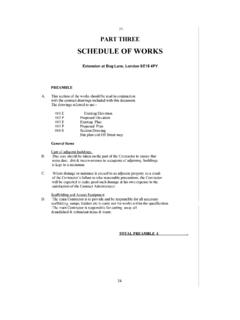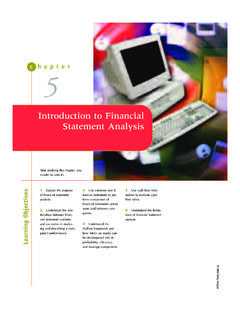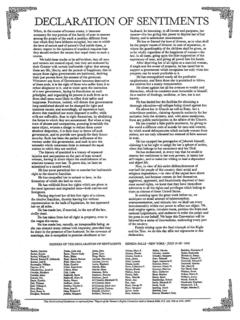Transcription of Section 1 Sheet 42 January 2000 - selfbuild …
1 WoodINFORMATIONJ anuary 2000 Section 1 Sheet 42CI/SfB(23)HiUDC I- joists :applications and design900338 The use of timber engineered structuralcomponents in the UK is growing; specificallytimber I- joists which have been successfullyused in North America and Scandinavia forover two decades. I- joists are now being pro-duced in the UK. They are factory producedwith extensive quality control checking toensure reliability of performance. In the UK,the route to market is via third-party certifica-tion which establishes safe design values foruse with British and European design I- joists comprise a timber flange(typically solid timber or LVL - laminatedveneer lumber) and a panel product web (usu-ally OSB - oriented strand board).
2 Timber floor joist products are underincreasing competition. The success of con-crete beam and block floor in the ground floormarket is a clear driver to find timber solu-tions to match these products. RecentTRADA Technology research, supported byDETR and TRADA member companies hasexamined the techno-economic opportunitiesfor I- joists in the first part of this Wood InformationSheet looks at the applications and uses oftimber I- joists , whilst the latter sections out-line some of the considerations and possibili-ties ofutilising UK material for Timber I-joistStructural principlesStructurally the I-joist works on the prin-ciple that the greatest forces in a beam underbending are at the outer faces.
3 Hence, if thestronger tensile and compressive material ispositioned at the outside edges, the centralzone can be reduced in size as it carries verylittle of the bending forces. However, the cen-tral zone (web) carries the reaction and shearforces. Commercially manufactured timberI- joists use high grade timber or structuraltimber composites for the flanges, routed toaccept a timber-based board web (orientedstrand board, K40 structural hardboard or ply-wood). The web is secured to the flange by anapproved weatherproof, structural adhesivewithin the high strength to weight ratio oftimber composite I- joists means that there isno need for heavy lifting equipment andreduced requirements for temporary storagespace.
4 I- joists can be easily handled on 1 Timber and steel I-joistsleft: factory produced, right: craft-basedFigure 2 I-joist with solid timber flanges andOSB web. Photo: James Jones & Sons Ltd2 Applications of I-joistsTypical applications for I- joists are in floors,roof framing (rafters, purlins), wall framing (studs)and whole structural portal frames and need to radically improve the constructionprocess in the UK, highlighted in the 1998 EganreportRethinking Construction,is encouragingthe uptake of products that improve constructionand in-service market research has identifiedthat I- joists used for intermediate floors presentcost-effective solutions, meeting user needs andbeing less costly than concrete alternatives, seeFigure ground floor applications the additionalcosts of oversite protection need to be considered,eg in England and Wales.
5 50 mm inert sand plusdpm or concrete over polythene (300mm) beddedon sand 3 Possible applications of I-joistsTop: Triangulated roof and floor joistsCentre: Portal unitsBottom: Cantilever rafter roof and studsDomestic (intermediate) (metres)cost ( /m2)beam and blocksawn sw C16I-joistsDomestic (compartment) (metres)cost ( /m2)beam and blocksawn sw C16I-joistsOffice/light industrial a n (m )cost ( /m2)beam and blocksawn sw C16I-joistsFigure 4 Cost comparisons of floor constructionsCosts based on 1998 prices, assuming a floor area x Includes incidental costs of additionalperimeter walling for deeper joists , installation costsbut does not include finishes3 Benefits for floor constructionI- joists provide the designer and installer withreliable quality controlled structural products.
6 Thehigh strength to weight ratio means that light-weight long span solutions are available. Theirfactory controlled moisture content characteristicsare ideally suited to avoid in-service shrinkagemovements. The benefits to the construction pro-cess of timber I- joists are similar to concrete sus-pended floors (typically beam and block). Acomparison of the two methods is summarised inTable 1:Table 1 Comparison of concrete suspended floors with timber I-joist solutionConcrete suspended floorsTimber I-joist solutionDesignFrom span tables. Flexible for span tables or from manufacturers design programs.
7 Flexible for capacityTypical market 4-6 market 4-6 m. Lengths availableup to 12 m for continuous span of constructionWet trades might be involved. But use ofOSB as a floating floor avoids wet material construction is the normalapproach. Can use concrete screed finishif insulationAdditional topping is needed can be included and electricalservicesSpecialist on site drilling for services orpre-planning in design and on site carpentry drilling for holesin web. No notching of flanges RegulationsFor high-level work use of wide span(plank) construction avoids use oftemporary work high-level work use of prefabricatedpanels (cassettes) to avoid temporarywork be left out but wetting may causemoisture build up in the completedstructure requiring drying outTo be kept dry by appropriate sheetcovers or dry wetted or exposed to weather/moisturefor a prolonged period the manufacturershould be consulted before resistanceUsed as part of a system to give firerating, eg.
8 Plasterboard ceilingI- joists to be incorporated in a system togive fire resistance, eg 15 mmplasterboard ceiling for 30 minutes(subject to test).A wider review of the application and optimi-sation of timber floors was undertaken in a sepa-rate TRADA Technology research project. Theresults are summarised in the reportTimber floors:improvements through process typical details for the use of I- joists forboth timber frame and masonry construction insingle dwellings are shown in Figures 5 and : the drawings are for illustration only; they donot show all the constructional details which maybe required for a particular floor, such as stiffen-ers, strutting 5 I- joists in block wall construction5 Figure 6 I- joists in timber frame construction6To ensure that the potential constructiongains and performance are actually achieved inpractice, designers and contractors need to beaware of some key points:uStability of I-joist during constructionThe depth to breadth ratio of an I-joist is rela-tively high and overturning of unrestrainedbeams can occur.
9 Temporary bracing beforedecking (floor) or sheathing (walls and roofs) isusually required. Fixing of the floor deck or roofbattens etc to the top flange of simply sup-portedjoistsprovidesessentiallateral restraint to the compression flange. The maxi-mum centres for restraint are typically 450 mmbut manufacturers literature should hangersThe joist hangers should be matched to theI-joist width and fixing requirements. Thereare proprietary BM TRADA Q-marked joisthangers that are specifically designed to sup-port to flangeThe depth and size of nails should be mini-mised to avoid splitting of the timber use of nail guns may be difficult on highdensity flange material.
10 Due to the compositenature of an I-joist only nominal loads shouldbe supported by the bottom flange I- joists stored on site should be storedvertically, out of ground contact and protectedfrom extreme weather stabilityBecause the flange is either a structuraltimber composite or small dimension timberthe potential for cross grain moisture move-ment is reduced compared to solid rectangulartimber beams. Care is needed, however, tounderstand the comparative dimensional sta-bility performance at lintel and timber frameheader support locations. A possible solutionis to use I- joists or a material such as LVL forheaders and lintels or to use hangers wherefloor members abut the wall framing).



